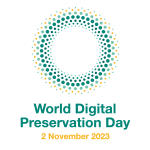
I am pleased to announced that The Ohio State University Libraries has launched it’s most recent digital preservation repository, the Gray Digital Preservation Repository or Gray Repo!
The Gray Repo is a service that provides a path to preservation for born digital (or received as digital) content that has been accessioned, and is only intended to be minimally processed and/or is temporally restricted. As such, and in accordance with the University Libraries Distinctive Collections’ accessioning policies and procedures, it is the default digital preservation repository. Further, it provides a preservation environment for some legacy digitized preservation files. It is a “dim digital preservation archive” that provides no public access, and limited curatorial access to the University Libraries’ digital objects stored within. This is in contrast to a “light archive” which provides public access, or a “dark archive” which only allows custodial access. The Gray Repo allows for curatorial deposit and retrieval, but no direct patron access. It is much more akin to a physical archival storage facility, much like our Book Depository, where items are stored on shelves in a environmentally regulated and well managed manner, and appropriately described in conformance with accepted standards, while the public and unvetted personnel are not allowed to wander the stacks.
This has been about 2.5 years in the making from the original scheming of the project, to design, testing, re-design, testing, redesign, testing, etc. etc. etc. It has truly been a team effort with University Libraries’ personnel from our Application Development and Operations, Digital Initiatives, Infrastructure Support, Information Security, Distinctive Collections, Archival Technical Services, Metadata Initiatives, Publications and Repository Services and Copyright Services advising or assisting Digital Preservation in constructing the environment. I would also extend our gratitude to our colleagues in the digital preservation community who have provided advice and guidance along the way, especially those in the Big Ten Academic Alliance, NDSA (National Digital Stewardship Alliance), iPRES and Society of American Archivists communities.
Workflow documentation will be forthcoming, albeit redacted from a cybersecurity point-of-view. You can learn more about our project at go.osu.edu/Gray-Repo-Wiki.
 Earlier this year, while attending iPRES 2024 in Gent, Belgium, I met a new colleague and friend, Folasade Adepoju with the Public Services Department of the National Library of Nigeria. She has graciously reached out and invited me to participate in Digital Preservation: A Beginner’s Guide. This presentation is in celebration of World Digital Preservation Day.
Earlier this year, while attending iPRES 2024 in Gent, Belgium, I met a new colleague and friend, Folasade Adepoju with the Public Services Department of the National Library of Nigeria. She has graciously reached out and invited me to participate in Digital Preservation: A Beginner’s Guide. This presentation is in celebration of World Digital Preservation Day.

